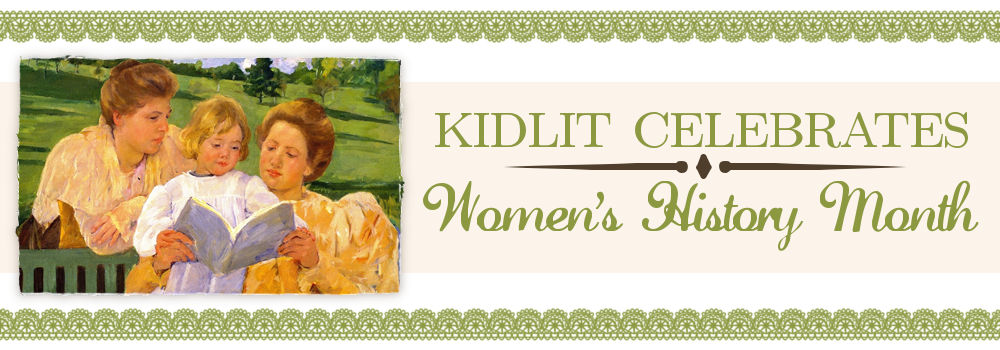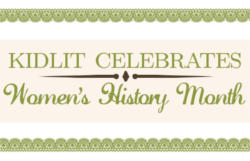March 31 - Today’s post provided by The Nonfiction Detectives
When I think about Women’s History Month, the name Susan B. Anthony pops into my mind right away. It’s surprising how many children in elementary school are not aware of Anthony’s contributions to women’s history. We own a number of biographies of Susan B. Anthony in the library, but I rarely see boys and girls checking them out for school projects or for pleasure reading. I recently chatted with a group of students about Susan B. Anthony. Most could not tell me what she was known for or what she accomplished. Teachers and librarians take notice, it’s time to break out the Susan B. Anthony books and begin reading aloud to the youngest generation. Alexandra Wallner’s picture book biography, Susan B. Anthony, (Holiday House, 2012) provides young readers with an accessible story of Anthony’s life and accomplishments. In just 32 pages, Wallner describes Anthony’s childhood in Massachusetts, her advocacy for women in her father’s mill, and her work as a schoolteacher before joining forces with Elizabeth Cady Stanton to work on the women’s suffrage movement.
Susan B. Anthony: Fighter for Women’s Rights by Deborah Hopkinson (Simon Spotlight. 2005) is another picture book biography that could serve as a starting point for students unfamiliar with Anthony’s work for women’s rights. The leveled reader is part of the Ready-to-Read series and would work well as a both a read aloud and as a book for newly independent readers to read on their own.
RACHEL CARSON AND SILENT SPRING
If Susan B. Anthony had not been an advocate for women's equality, would Rachel Carson have had the opportunity to attend college? Luckily, she did because in 1962 Rachel Carson published her most important book, Silent Spring. It was published to applause and severe criticisms. Battling breast cancer, it took the courageous Carson four year to research and write. This important tome was written to alert people that insecticides were deadly to birds, insects, fish, other animals, our land, and also to people.

In her picture book biography, Rachel Carson and Her Book that Changed the World, (Holiday House, 2012) author Laurie Lawlor and illustrator Laura Beingessner successfully conveys Carson’s determination and indomitable spirit. Most of the book’s 32 pages are devoted to Carson’s early life, her education, her family problems, and the frustration that men would not take her seriously as a scientist. Throughout her lifetime, Carson was a careful observer of nature and was saddened as trees were cut down to build homes and factories whose putrid smells and smoke clogged the air.
Carson also loved the sea and as a marine biologist would write extensively about the ocean. During the 1950’s Carson’s keen sense of observation noticed some disturbing trends. Rising sea temperatures, and more and more garbage being dumped in the ocean was having a disastrous affect on the web of life. The last three pages of this book are devoted to Carson’s work on Silent Spring. “As early as 1945, Rachel had read about studies of declining bird populations across the country. Each year researchers reported fewer nesting and migrating birds. The more she investigated, the more alarmed she became.” The chemicals created for use during World War II were being used haphazardly to kill insects on farms, in city parks, nature preserves, swimming pools, in neighborhoods, and even on crowded city streets.
It took great courage to stand up to the big chemical industry. People claim Silent Spring started the whole environmental movement. It certainly had an effect on those who have made it their life work to educate people about the dangers of pesticides and insecticides.
2012 is a presidential election year in the United States, and it’s the perfect time for teachers, librarians, and parents to introduce their children to courageous women, such as Susan B. Anthony and Rachel Carson. Picture books are an excellent way to teach about these brave and determined women.
Editor's Note:
Cathy Potter is K-5 school librarian in Falmouth, Maine. Cathy reviews apps for School Library Journal and currently
serves on the Southern Maine Library District's Board of Directors. She served
as a nonfiction picture book judge for the 2011 CYBILS awards and is currently a
member of the Chickadee Award committee in Maine.
Louise Capizzo is a Youth Services Librarian at a public library in Scarborough, Maine. Louise has written reviews for Publisher's Weekly, AudioFile Magazine, and Kirkus Reviews and served on many committees including the Maine Cream of the Crop committee (2001-2009), the Maine Student Book Award Committee (2006-2010), the 2011 John Newbery Committee, and served as a judge for the 2011 CYBILS awards.
Louise Capizzo is a Youth Services Librarian at a public library in Scarborough, Maine. Louise has written reviews for Publisher's Weekly, AudioFile Magazine, and Kirkus Reviews and served on many committees including the Maine Cream of the Crop committee (2001-2009), the Maine Student Book Award Committee (2006-2010), the 2011 John Newbery Committee, and served as a judge for the 2011 CYBILS awards.
Together, Cathy and Louise are The Nonfiction Detectives.










.tiff)










+and+the+Tuskegee+Golden+Tigerettes+relay+team.jpg)
















